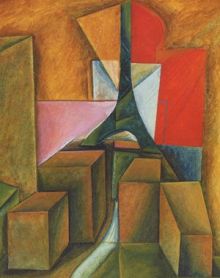As there is no governmental support, socially responsible businessmen decided to show the real cultural face of Ukraine. Owing to one of such initiatives the Kyivites have been able to see the works of Borys Kosarev, one of the most interesting representatives of Ukrainian avant-garde. Recently, the Stedley Art Foundation hosted the launch of the international exhibit project “From lotus to a sickle: Kharkiv in Borys Kosarev’s creative work.”
In a short while, the foundation and Rodovid gallery will bring the Kharkiv artist’s works to New York, where they will be displayed at the Ukrainian Museum. It should be noted that the first, and the last, time the world saw Kosarev’s works was in Paris in 1937.
Borys Kosarev (1897-1994) resided and created in Kharkiv. At the time the city was the capital of Ukraine. The Ukrainization was developing large-scale, which could not but influence Kosarev. In his creative work he frequently turns to folklore motives.
The artist had a wide sphere of creative interests: he painted, photographed, was involved in theater design and graphics (created book illustrations, painted posters, and billboards). He was a participant of the Kharkiv group of young artists “The Union of Seven.”
Kosarev matured as an artist in the milieu of such representatives of the avant-garde culture as Velimir Khlebnikov, Davyd Burliuk, Nikolai Aseev, Syniakov sisters, Vasyl Yermilov, Boris Glagolin, Oleksandr Khvostenko-Khvostov, Anatol Petrytsky, Danylo Demutsky, and Oleksandr Dovzhenko.
The Authors of the first scholarly monograph about his creative work, Borys Kosarev: the 1920s. From painting to theater-cinema-photography, Tetiana Pavlova and Valentyna Chechyk, underline that the artist, on the one hand, is a typical figure of the Ukrainian avant-garde, but at the same time, he responded to the time’s innovations in an original manner. An important motif of his creative work was the architectural image of Kyiv Sophia.
A significant moment in Kosarev’s creative activity is his cooperation with outstanding Oleksandr Dovzhenko while shooting Zemlia. The art experts admit that Dovzhenko never included occasional people in his team, only those, whose opinion was really important for him.
The international project which will be launched in New York will consist of 105 works by Kosarev, created in his most fruitful period, 1915-35. For many years the collection has been gathered and preserved by the artist’s daughter Nadia Kosareva.
She told The Day that it was not a simple thing to do: real masterpieces were hidden for the most part, because being a futurist in Soviet times meant practically sentencing yourself to death. Many of his works were ascribed to other Authors.
“They say that one can succeed in art by being witty or immodest.
For example, looking at the mug created by Borys Kosarev you tend to understand that quite a serious culture stands behind it,” art expert Dmytro HORBACHOV says, “That is the culture of icons, so much adored by avant-garde artists in their time. Maria Syniakova’s support was a great joy for the then young artists. One can trace in Kosarev’s works that she was his teacher. Syniakova was Khlebnikov’s muse. By the way, Khlebnikov considered poverty to be the artists’ advantage. Kosarev and Yermilov lived through poverty as stimulus.
“They thought that a satiated man was not inclined to creative work, whereas the creativity of a hungry person reaches extraordinary summits. That was the philosophy of the time: the less, the better. Malevich’s art was of the same kind: poor, yet full of energy. It was passed to Kosarev in this manner. I met Kosarev and even spent a whole day with him. I am very glad that I ma-naged to write down his reminiscences at that time. But I noticed that he was very careful as he spoke not to say something improper. For almost all in his surrounding had been executed.
“But the powers that be managed to destroy neither the artists, nor the art. It was suppressed, but it forced its way nevertheless. All these artists, Kosarev in particular, did not become propagandists, though they received such orders. Kosarev had an aesthetic approach, he was an aesthete of the new art, and politics served as a material for him [however, it is significant that when the Stalin’s large-scale attack on Ukrainian peasantry started, Kosarev responded to this, creating a cycle of photographs ‘Sorochyntsi Fair’ in 1929. – Ed.]. Some of his students told a story as one of them received a sideline order to paint Marx’s portrait. He read four vo-lumes of Capital and yet he was embarrassed: how to paint him? Kosarev replied, ‘Do you need to read Capital to depict a man with a beard?’”
Kosarev was indeed a great artist, like all of his brothers-in-arms: Kurbas, Petrytsky, Dovzhenko, Malevich, Yermilov, etc.
Photo replicas from the book Borys Kosarev: the 1920s. From painting to theater-cinema-photography (Kyiv: Rodovid, 2009)










